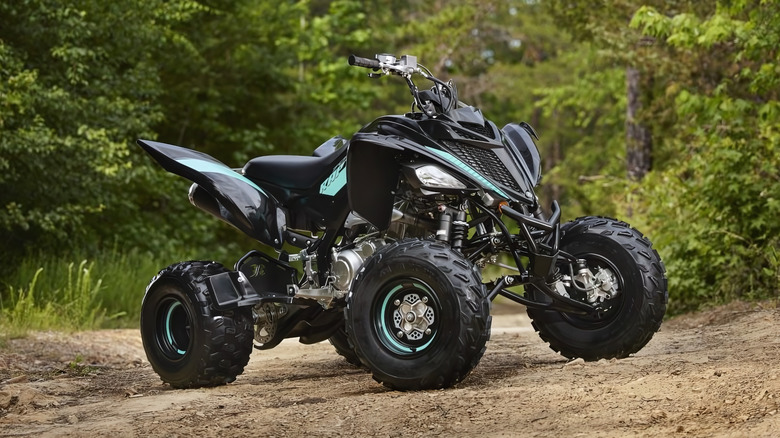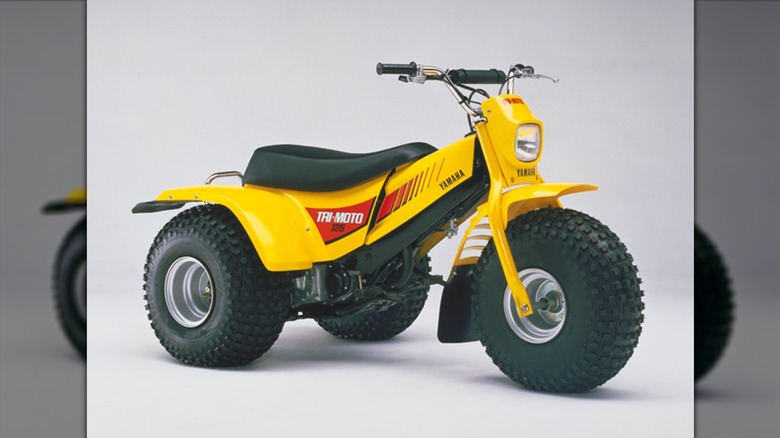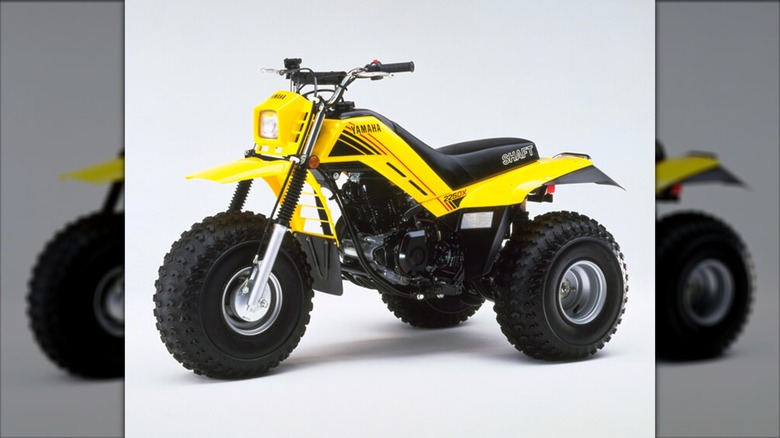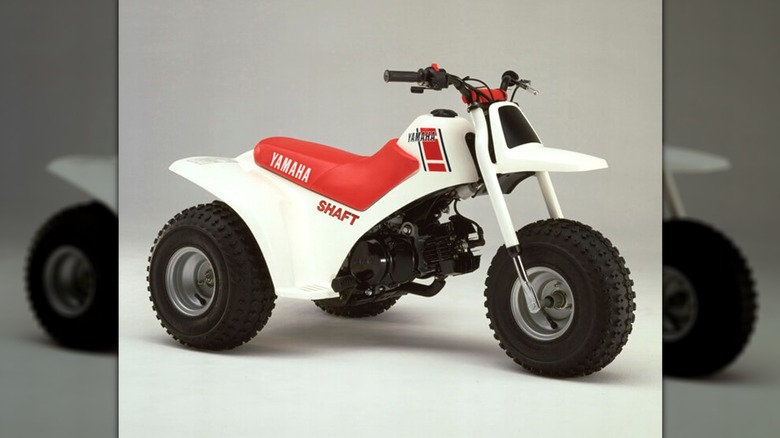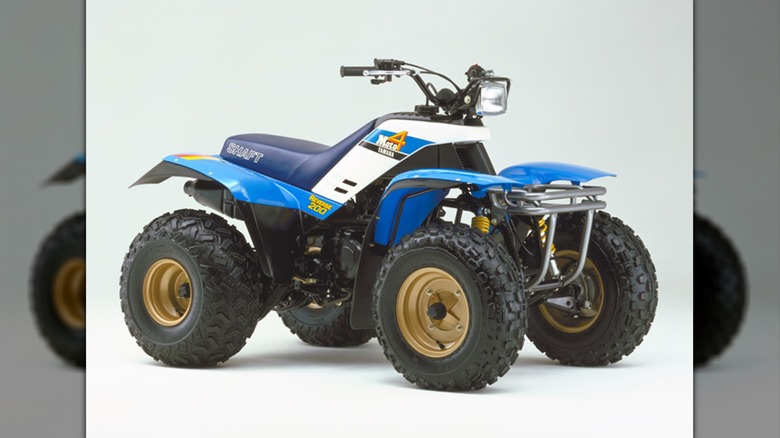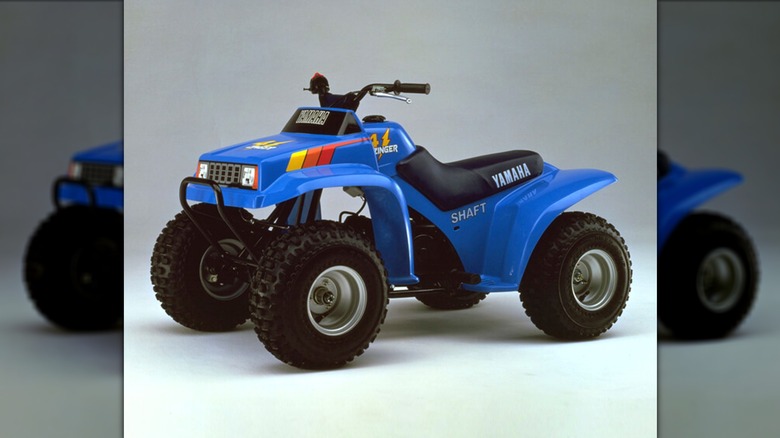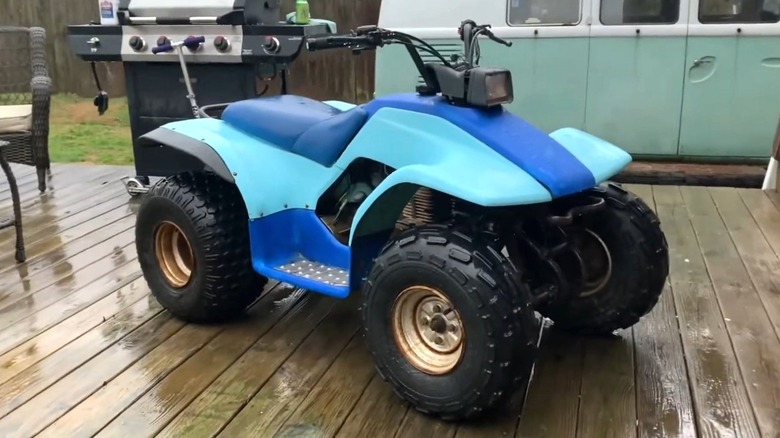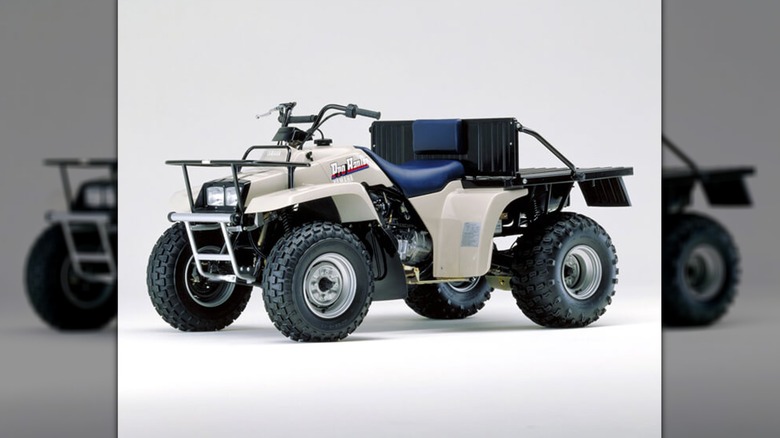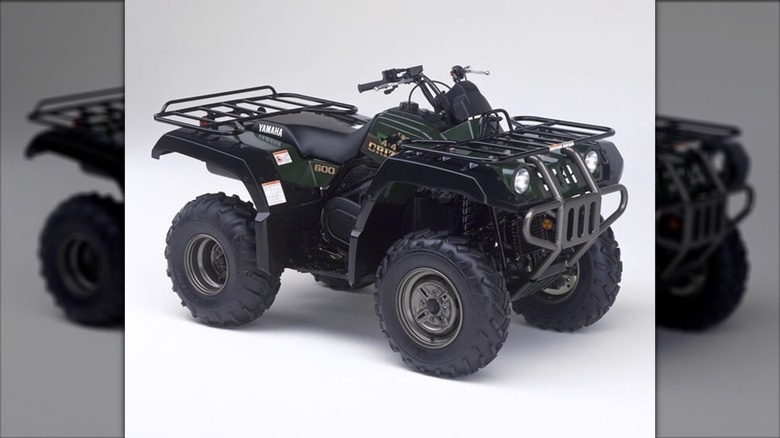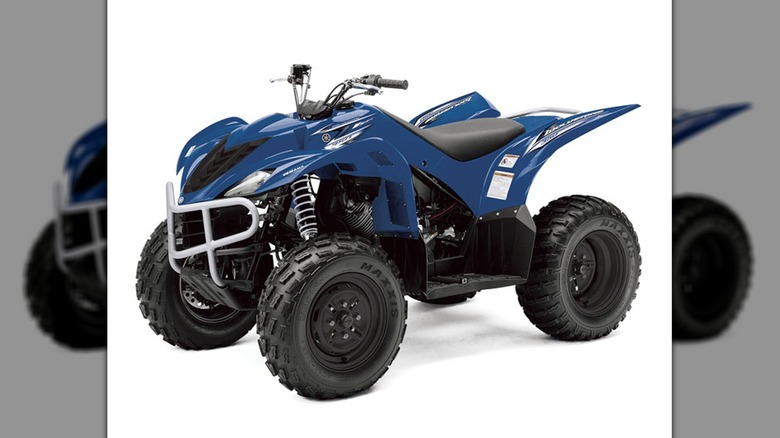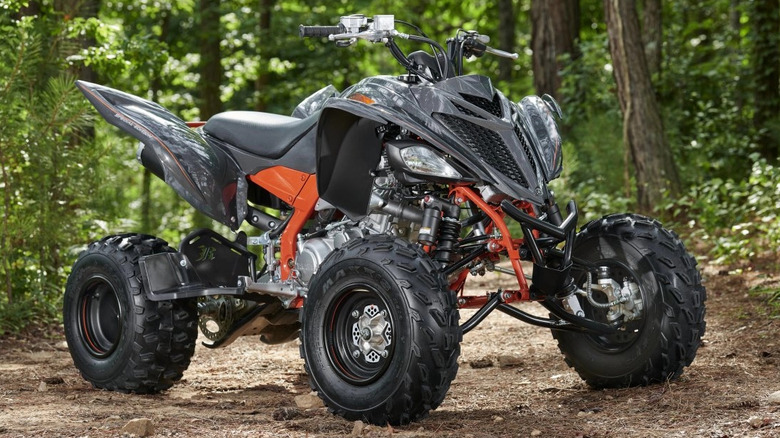10 Of The Coolest Looking Yamaha ATVs Ever Made
Honda may have pioneered the ATV market with 1970s US90 three-wheeler (later renamed the ATC, under which name it gained infamy for being banned in America), but it's far from the only Japanese giant making these fun, off-road vehicles. Arch-rival Yamaha took a while to come out with its own ATV thanks to some effective patents on Honda's part, but when it did, it set the tone for nearly 50 years of eye-catching ATVs.
Yamaha's debut ATV, the Tri-Moto YT125, came out in 1979, but the company quickly made up for lost time, harnessing the nearly 25 years of motorcycle experience it had accrued since splitting from Yamaha Corporation to rapidly iterate on the basic formula. It released a flurry of three-wheelers in the years after before debuting the four-wheeled YFM200 in the mid-1980s. The Japanese manufacturer hasn't stopped since, releasing a frankly dizzying number of ATVs in the nearly 50 years since that plucky little three-wheeler.
It's not just the sheer number (around 70 as of 2024) of Yamaha ATV models that impresses; it's also their style. From brilliant examples of 1980s chunkiness to the hyper-aggressive lines of its modern sport ATVs, Yamaha's designers have always found ways to make them look great. Sure, you could argue that ATVs are inherently cool anyway, but more than a few of Yamaha's ATVs have been a cut above the rest in the coolness stakes. Without further ado, let's dive into the world of Yamaha's coolest-ever ATVs.
1979 Yamaha Tri-Moto YT125
It took the Yamaha Motor Corporation around 25 years to dip its toes into the ATV market, but it made a splash when it did. 1979's Tri-Moto YT125 followed in the all-terrain cycle (ATC) archetype Honda kicked off earlier in the decade. It was a boxy, bright yellow three-wheeler with fat, knobby tires under beefy, square fenders. The sporty look wasn't just for show, either: the 123-cc two-stroke motor sitting between the rider's legs produced a healthy eight horsepower at around 6,000 RPM, which must have been exciting on a three-wheeler weighing only 262 pounds.
Other notable features included a five-speed transmission and its Autolube system, which eliminated the need for pre-mixing the gas and oil — otherwise essential for a two-stroke engine. Yamaha also specced a snorkel air intake for the engine, letting riders go ham in the dirt and mud without worrying about sucking water into the engine. Despite being a Japanese product, the YT125 debuted in the U.S. first, hitting dealerships in 1979, before coming to Japan in 1982 alongside a larger 175-cc version.
Popular Mechanics tested the YT125 and YT175 and found that even the smaller ATV was a handful, all too happy to lift the front wheel and requiring quite a bit of skill to ride. It concluded that the Yamaha YT125 was more suited to blasting around a track than muddy work in the yard — as if anybody buying a bright yellow three-wheeler in the '80s would ever use it to potter around their farm.
1983 Yamaha Tri-Moto 225DX
Yamaha may have taken its sweet time to enter the ATV market, but the company went on a tear once it did, releasing a flurry of models in the early 1980s.At least in our book, one of the coolest ones is the Tri-Moto 225DX, essentially a YT125 on steroids that debuted in 1983. The yellow paint and huge knobbed tires remained, but everything else looked even sportier, ready for even more hours of fun in the mud.
Witness: the more aggressive styling, with its squared-off dirt bike-style front lamp and raked fenders; the black-and-red speed stripes across the fairing; and that incongruous white "shaft" written on both sides of the seat. It's characterful, it's eye-catching, it's gloriously 1980s. Of course, Yamaha was likely referencing the fact that the 225DX had a shaft drive instead of a chain drive with that text, but it's so obtuse that you might as well take it as a fun bit of pointless aesthetic flair.
The 225DX had a 223-cc, four-stroke engine making an impressive 11.6 lb-ft of torque, which is plenty of pulling power for a 317-pound trike. And Yamaha didn't just upsize the engine: the 225DX had full front and rear suspension, electric start, fully enclosed disc brakes on the rear, and a more forward engine position. All of this made for an ATV cool enough to get its own ⅛-scale RC version. We're pretty sure not even Yamaha's coolest motorcycles ever got that treatment.
1984 Yamaha Tri-Zinger YT60
1984's Tri-Zinger was Yamaha's entry into the children's ATV market, promoted alongside a couple of two-wheelers in the PW50 and PW80. Befitting its target market, the YT60 had a tiny 59-cc, two-stroke engine with the same Autolube system present on the pioneering YT125. Yamaha also opted for an automatic shaft drive transmission, further making it a beginner-friendly ATV and justifying, once again, its decision to plaster "shaft" across the body — not that we're complaining.
The YT60 looked a lot like the YT125, just scaled down. Yamaha also opted for larger fairings that fully enclosed the rear tires as a safety measure, but we think the swathes of plastic — in white, yellow, or blue — give the YT60 a charming look. It's neither sporty nor edgy but has a certain toylike appeal, looking like a kids' model blown up to real-life size. It has "1980s" written all over it, and it's easy to imagine a kid running riot on one of these in the summer of '85.
Other child-focused features included a lever throttle instead of the conventional twist throttle for easier throttle control. This also meant that riders only had one brake lever that worked on both wheels simultaneously, again lowering the barrier of entry. It also had a kill switch on the rear to which parents could tie a lead; pulling on the lead would operate the switch and kill the throttle — great for ensuring kids didn't get too rowdy on the Tri-Zinger.
1984 Yamaha YFM200
1984 was a busy year for Yamaha, with three ATVs making their way to dealers that year. The YTZ250 was an even more dirtbike-styled take on the three-wheeler YT family, but we're also big fans of the YFM200, Yamaha's first foray into the world of four-wheeled ATVs. The YFM200 signaled a shift toward the boxy design language that most of Yamaha's 1980s and early 1990s ATVs would take, further separating the ATV from the vaguely motorbike-styled designs of the early three-wheelers.
Yamaha sold the YFM200 in several color schemes, including the classic yellow with red decals of the YT125 and 225DX and an inverted yellow-on-red. But the best has to be the classy white-and-blue color scheme that Yamaha offered with bronze wheels in 1987. This particular colorway made great use of all the extra surface area that came with having four wheels, with the color-blocking very reminiscent of the racing-style colors on overlooked Yamaha motorbikes such as the RZV500R. The dark blue seat material was just the icing on the cake.
The YFM200 probably wasn't much of a sport ATV, but its 200-cc engine did make a decent 15 horsepowerat 7,500 RPM. That extra power compared to older Yamaha ATVs was likely necessary, though, as the extra wheel brought the YFM200's weight up to a shade over 400 pounds — over one-and-a-half times heavier than the YT125 from five years ago.
1985 Yamaha Moto-4 YF60
1984's four-wheeled YFM200 marked a definitive break from the "tricycle-with-engine" ATV design it had used since 1979's YT125, and Yamaha would never go back after that. So, what would it do about the kids' ATV market? Well, release a new four-wheeled ATV for kids, of course. Enter the YF60.
The YF60 — officially called the Moto-4 but commonly called the 4-Zinger, based on the decals — was probably Yamaha's quirkiest ATV yet. The mechanicals weren't anything new, with the same 59-cc two-stroke engine the company had used previously in the YT60 still tasked with punting kids forward with 3.6 lb-ft of torque. Yamaha also carried over the single-speed automatic transmission and low-maintenance shaft drive from the three-wheeled YT60.
The YF60 was a YT60 with an extra wheel. That's all well and good, and there's nothing wrong with that, but — for whatever reason — Yamaha thought it would be appealing to style the panels and decals to make the YF60 look like a tiny pickup truck. It had a truck-style front end, complete with a stick-on grill and headlamps, plus a miniature bull bar. Why did Yamaha think children wanted to ride an ATV that looked like a pickup truck? We have no idea. However, it's certainly charming and one of the more notable models in the nearly 50 years Yamaha's been building ATVs.
1988 Yamaha Breeze YFA-1
Yamaha's YFA-1 from the late 1980s stands out amongst the brand's catalog, albeit not in the most obvious way: Where most of Yamaha's other nature-themed ATV names evoke the power and might of animals — the Raptor and Grizzly Bear on this list, for example, as well as four-wheel-drive Big Bear — the YFA-1 Breeze brings to mind nature's gentler, softer side.
The Breeze wasn't a slouch, though: its four-stroke, 124-cc engine made 6.3 lb-ft of torque, more than enough to have fun considering its 298-pound dry weight. Yamaha may have named it Breeze in reference to the user experience, which would have been very simple thanks to its fully automatic transmission — with a dedicated reverse gear, no less — and electric starting. Swing axles front and rear rounded out the mechanical package.
That said, the Breeze's styling did reflect the name somewhat. The Breeze had much more bodywork than most of Yamaha's ATVs, with its side body panels extending down and doubling as full-length footrests. Unlike many of its stablemates, the YFA-1 wasn't necessarily quirky, chunky, or sporty; instead, there's an almost dolphin-like quality to the bodywork here, especially in blue.
1989 Yamaha ProHauler YFU-1
Yes, the YFU-1 is beige. Yes, it's a utility ATV. No, neither of these are really all that cool on their own. But somehow, Yamaha's ostensibly boring, trailer-hauling ATV oozes a specific sort of style and appeal that looks great 35 years on from its debut. Is it just our collective nostalgia for the late 1980s and early 1990s? Maybe, but let's dive into the ProHauler a bit further before discussing that.
The YFU-1 is an unashamedly po-faced ATV, with practical luggage racks front and rear — allowing it to carry 466 pounds, in addition to its 800-pound towing capacity — dominating its design. It has chunky fenders to keep the mud away from you while hauling gear, and the tubular chassis protrudes at the front to serve as a bull bar, protecting you in case you bump into some terrain while hauling gear. The mechanicals were very practical, too, with its 11.4-horsepower, 12.2-ft-lb 230-cc engine delivering power via a dual-range transmission for better towing across all terrain.
One could argue that the YFU-1 is so boring it's cool again. It's all function, with every detail representing Yamaha's goal of making a heavy-duty, load-hauling ATV — right down to the ostensibly unremarkable color. There's also something about it that, oddly, brings to mind Hideo Kojima's "Death Stranding." The ProHauler's minimalist, functional cool would fit right in with the game's other vehicles. Perhaps it would have to trade the beige for a cool blue-gray instead.
1997 Yamaha Grizzly 600 YFM600
If the Breeze was an allusion to the gentler side of nature, then the Grizzly 600 was the complete opposite. Yamaha's late 1990s flagship ATV was all brawn, with a 600-cc engine mated to a toggleable four-wheel drive system and automatic transmission, all delivered in a chunky body that was a symphony of plastic and metal — albeit one composed by a modernist like Prokofiev, all jagged chords and dissonances.
Yamaha never disclosed the horsepower or torque output of the Grizzly's engine, but it was capable of hitting nearly 60 mph: not a patch on any of Yamaha's fastest bikes, but no small feat for a 639-pound ATV on dirt. Befitting its namesake, the Grizzly was a large ATV, its nearly 46-inch width consisting of burly fenders, luggage racks rear and front, and a front bull bar that wouldn't look out of place on an off-roading jeep. It's not a gentle-looking ATV, but everything comes together to give off an air of powerful confidence. Oh, and then there's the small detail of the stylized grizzly bear in the Grizzly's logo, which perfectly sets the whole ensemble off.
Finished in a deep forest green, the Grizzly 600 lived up to its name in power, looks, and off-road capability. Contemporary reviewers praised its high-quality suspension, overall riding experience, and general utility, the latter attributed to its automatic transmission and engine braking functionality. The least you could expect, then, had you dropped $6,499 — just under $13,000 in 2024 — back in 1997.
2007 Yamaha Wolverine 350
The Yamaha Wolverine 350 was another step in Yamaha's gradual escalation of its choice of animal namesake; where the Grizzly was beefy and powerful, the 2007 Wolverine 350 was all lean, aggressive muscle, its bulging bodywork living up to the wolverine's fierce reputation.
Yamaha didn't stray too far from the design language it established with the Raptor, with the Wolverine's pointedly extended rear fenders and exaggeratedly nose sharing much with its bird-themed sibling. But what set the Wolverine 350 apart was that front bumper: it looked almost like a gridiron helmet's facemask, giving the impression of barely concealed energy ready to let rip at a moment's notice. It's not the understated, utilitarian style of something like the YFU-1, but it's still cool for what it is: an all-action sports ATV.
The 2007 Wolverine 350 wasn't the first-ever Wolverine in Yamaha's stable, but the previous models didn't quite catch the eye like the 2007 model. They did, however, have dedicated four-wheel-drive and a manual transmission — neither of which this model had. Instead, Yamaha went with two-wheel drive and a CVT to put the 348-cc engine's power to the dirt — not quite as hardcore, perhaps, but still a pretty sporty setup, especially with its 478-pound dry weight.
2024 Yamaha Raptor 700R SE
Yamaha's Raptor family of ATVs has always been special, all high-performance dirt machines with edgy styling that recalls their avian namesakes. But the 2024 Raptor 700R SE, the flagship of the Raptor family, is likely our favorite. The 2004 700R SE turned the dial up to 11, pairing the exaggerated wing-like extended rear fenders and beak-like front of Yamaha's sport ATVs with two colorways that help set it apart from its smaller — and more affordable — siblings.
The KTM-aping orange-and-gray colorway brilliantly showcases the 700R SE's exposed chassis, bringing to mind some of the best naked bikes out there, while Yamaha Black is an '80s-fueled throwback with neon turquoise highlights on blacked-out panels and frame. Sure, neither colorway is particularly tasteful, and they make the Raptor 700R SE about as subtle as a hammer to the face, but this is a 686-cc sport ATV we're talking about here: any definition of "cool" that involves subtlety and discreet style don't apply here.
As you might expect for a nearly $11,000 ATV, the 2024 Raptor 700R SE is all show and all go. That liquid-cooled 686-cc engine revs to 9,000 RPM, while features such as fully adjustable suspension, Maxxis tires, five-speed manual transmission, and disc brakes make it a capable beast no matter the terrain you're trying to conquer. It's a steep price to pay, but you'll get your money's worth — and then some — if you shell out for one of these.
